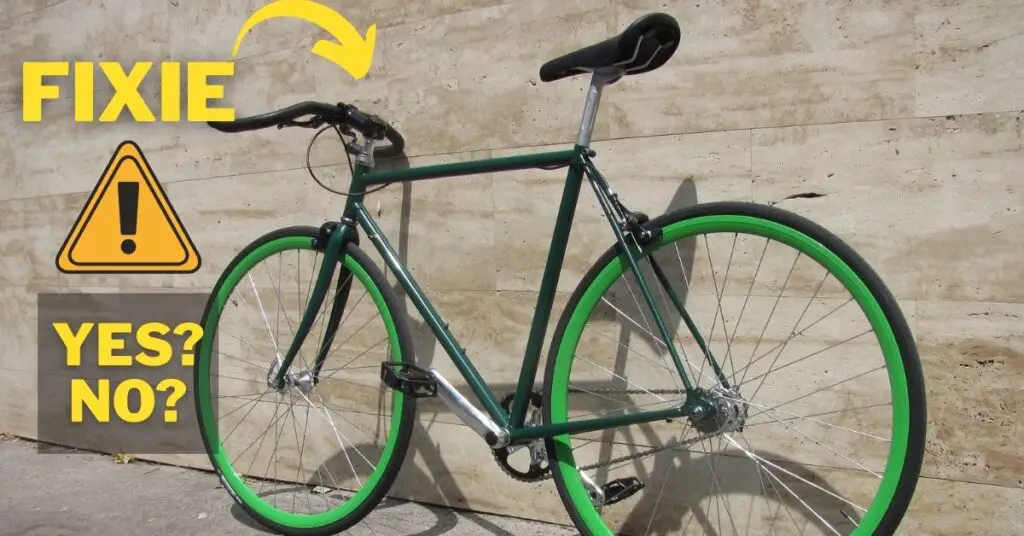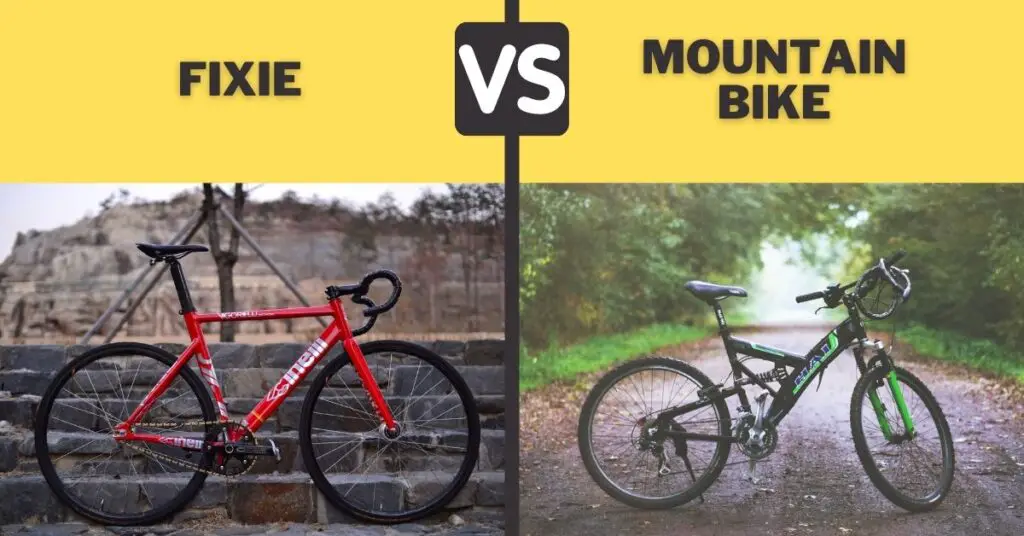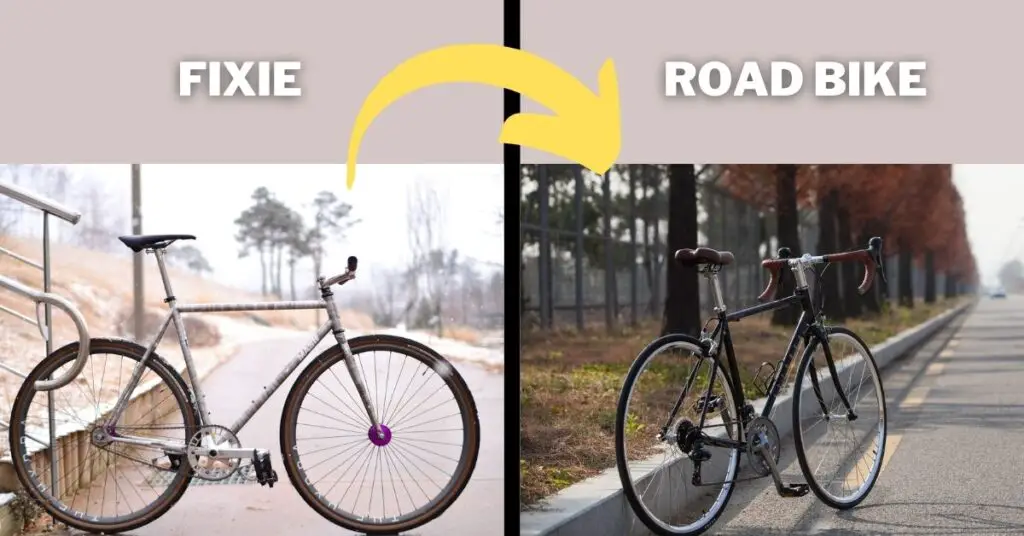This is always going to be an open-ended question, as there are no set guidelines that specify what your fixie should have a standard weight.
The general misconception is that fixes weigh less than their multi-geared counterparts, but this isn’t always the case. The thing to remember is that the parts on your fixie are usually beefier and the frame is also built from stronger and heavier materials.
But, we love our fixies because we can customize and modify them, so let’s look at how much they usually weigh, where we can shave weight off, and how that compares to other bikes out there.

How Much Do Fixies Weigh?
As I mentioned before, there is no hard rule for what the weight should be. Generally speaking, a fixie would weigh between 20 and 25 lbs.
There are obviously a few variables on your bike that will make up this weight, so let’s look at the anatomy of your bike before we go any further.
What Makes up the Overall Weigth of a Fixie?
1- Frame & Fork
Usually, a repurposed road bike frame is made from aluminum, steel, or even carbon fiber. Commonly bicycles are made from Chromoly, this is chrome-alloy steel that is stronger than carbon steel and also gives you a lighter frame that is very durable.
Possibly the largest single contributor to your bike weight, frames can range between 3 & 10lbs, with forks averaging around 2lbs
2- Crankset & Rear Cog
The size of the crankset & cog will have a massive part to play in how your bike rides. It will affect cadence and technique and will also play a role in how you accelerate and slow down.
With varying sizes, there will also obviously be a variation in weights.
3- Seatpost & Saddle
Depending on your preference, the saddle is usually a smaller, lightly cushioned option found on road bikes. You could also pick a saddle from a mountain bike or a hybrid saddle for more comfort.
These components combined average around 2-3 lbs.
4- Handlebars
There is so much scope for variation in the handlebars and you’ve probably seen all types of handlebars on fixies. Everything from the classic drop-down style found on road bikes to shortened handlebars is an aspect that will not only shape the aesthetic of your bike but also plays a big part in how the bike steers and also the comfort of the ride.
Depending on the material they are made of (carbon and aluminum or common) and the type of handlebars you use, can vary between 7 and 12 oz.
5- Pedals
Platform pedals are the most common, the simplicity they offer fits in nicely with what a fixie is all about. But it’s worth considering lipless and holster pedals too – these will offer more control especially when braking.
Pedals should weigh around 7-14 oz.
6- Wheels
Another area where personal preference plays a big part. Wheels have many different things to consider. You have to consider section depth, tubeless/clincher or tubular, and the aesthetic you prefer. These choices all have their pros and con’s and they will also have varying weights to consider too.
On average, wheels will weigh between 3 and 4 lbs.
You can see how easily your fixie can start to pick up weight and, very often with beginner or entry-level models don’t have high spec components and tend to be on the heavier side. But again, we love our fixies because we can modify them as and when we want to.
Weight comparison (Fixies Vs Other Types)
You might be wondering how the weight of your fixie compares to other types of bikes out there. I’ve put together some examples to show the main differences between them;
Bike Type: Fixies
Avg. Weight: 21lbs
So we know that our fixie’s main feature is that it only has one gear. It’s a “simple” bike and is very often easier to maintain as there are fewer parts to it. They are also known as track or fixed gear bikes.
Bike Type: Road Bike Avg. Weight: 17lbs Designed for speed, these are some of the lightest bikes on offer. Skinny tires are designed to reduce resistance on the tarmac and drop handlebars off the ideal position to reduce wind resistance. Fixies often borrow components from road bikes to keep weight down.
Bike Type: Mountain Bike Avg. Weight: 25lbs These bikes are obviously built to be a bit more rugged. Frames are chunkier and sturdier to ensure they can handle the rugged terrain without taking damage easily. And chunkier tires provide better grip in wet or muddy terrain.
Bike Type: City or Commuter Bike Avg. Weight: 44lbs These are designed for city use, and so are usually equipped with practical accessories like lights, bags, fenders, or racks. While these are good for comfort and transporting goods, they add a lot of overall weight to the bike.
Bike Type: City or Commuter Bike Avg. Weight: 22lbs A bit of a hybrid between a mountain bike and a road bike, they have light-weight frames so they can be easily carried over through obstacles, but also have chunkier off-road tires for wet or muddy terrain.
Bike Type: BMX Avg. Weight: 27lbs A heavy bike when you consider its size, they are primarily designed to be strong enough to handle jumps and tricks without breaking. Generally used on shorter dirt tracks and in skate parks.
Bike Type: Tandem Bike Avg. Weight: 62lbs These are built specifically for 2 riders they need to be bigger and have to be able to support that additional weight This means that they are much heavier than other types of bikes on the market.
Bike Type: Electric Bike Avg. Weight: 45lbs There are lots of variables on the weight of an electric bike such as the battery and the motor size. But they are generally much heavier because of all the additional components used. It depends on the style of the e-bike too.
Bike Type: Folding Bike Avg. Weight: 32lbs Designed for ease of transport, these bikes can be used in the city and are easily transported on subways or you can put them in the boot of your car. Smaller frames and wheels keep the weight down too.
Bike Type: Cruiser Avg. Weight: 40lbs Typically used on flat terrain and over much shorter distances, these bikes are designed with style and comfort in mind. High handlebars and decorative and functional accessories like fenders and chain guards add to the overall weight.
Bike Type: Recumbent Bike Avg. Weight: 44lbs These are designed for stability and depending on accessories and steel bases the weight can often exceed 40lbs.
Bike Type: Touring Bike Avg. Weight: 29lbs Again, the weight here will depend on the accessories added. Touring bikes are made for distance riding and to be stable under loads. Added bags, racks, and lights all increase the weight.
Bike Type: Cargo Bikes Avg. Weight: 49lbs These bikes have multiple uses and can be modified to suit any needs. Additional framing and cargo containers add to the overall weight but these bikes are more often adopting e-bike technology.
Bike Type: Fat Tire Bike Avg. Weight: 35lbs These bikes are all-terrain bikes but their appeal lies in "floating" over tricky surfaces. They are much heavier than mountain bikes and so aren't as easier to pedal over normal terrain.
Bike Type: Gravel Bikes Avg. Weight: 25lbs Another road/mountain bike hybrid the main difference between this and a cyclocross bike lies in their geometry. Cyclocross usually has shorter chainstays and a lower stack height. Gravel bikes are designed for all-terrain but are built to handle rugged terrain far better than road bikes.
Bike Type: Klunker Bikes Avg. Weight: 26lbs Another hybrid, these bikes are part BMX, part mountain bike, and part cruiser. They usually have a "retro" inspired look, and while they are inspired by off-road and trick bikes, they are probably best suited for cruising and smaller trips.
What is the Lightest Fixie?
Out of interest, one of the lightest bikes on the market is the PG x Bugatti. Made almost entirely from high-performance carbon fiber they have managed to keep the weight under 11lbs. Not surprisingly though, it has a pretty hefty price tag too.
Some Light Fixed Gear Models
If that price tag scares you though I found one rider who has made it his mission to get his fixie as light as possible and has managed to get it to just under 12lbs.
The average person though lies somewhere in-between these two extremes. So let’s take a look at some stock light-weight fixies that represent sound investments. I’ve picked three examples at different price points that I think are quality bikes.
1- Aventon Cordoba
This is a beautiful-looking bike that screams speed. And, as usual, Averton hasn’t compromised on quality. It has a sleek design with an aluminum alloy frame and a carbon-bladed fork.
Most of the components are Aventon branded, but the quality is evident. Fixies are often considered a tough ride, but this bike is light and responsive and well worth its price tag.
2- State Bicycle Co. 6061 Black Label V2
A very robust bike, it has an aluminum frame and a full carbon frame. While some of the parts used were unbranded, they were not cheap and so the bike is widely considered to be priced well.
Thick piping and an aggressive geometry make it a very attractive bike too. A few concerns that were raised included the wheel-set and tires.
The deep-rim wheels are considered weighty and the tires themselves were a little narrow.
3- TRACKMACHINE 02 ONE
The most expensive of my picks by far, this bike is designed with performance in mind.
The aluminum frame and carbon forks make it sturdy and keep it agile, perfect if you are considering doing racing. Miche Pista components give this bike strength, durability, and reliability.
While the cog and chain encourage a high cadence.
Final Thoughts!
At the end of the day, you need to find the right balance for you and your fixie. It is a personal preference on how you like your bike to feel and perform in your surrounding and if that means that you carry a few extra pounds on your bike then so be it.
And I’ll say it again, we love our fixies because we can modify them as we need or want to, this means that our bike can grow with us and we can figure out exactly what we like.
Cheers!




